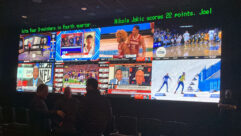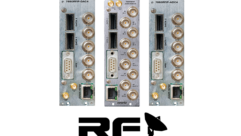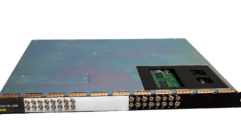DISTRIBUTION of digital television signals
Aug 1, 2000 12:00 PM,
Peter H. Putman
In last month’s column, I covered the problems inherent in trying toreceive dependable 8VSB DTV signals and mentioned the significant problemspresented by signal multipath. Indeed, multipath is the biggest problemconfronting the ATSC 8VSB (Eight Level Vestigial Sideband Modulation)standard, adopted after much debate and political maneuvering in 1995.
Although 8VSB works well in suburban and even some rural environments, itis not proving to be as robust in the concrete canyon locations of largecities – areas where signal multipath is a fact of life. For analog TVtransmissions, that is not as much of a problem. Many city-dwelling TVviewers have grown accustomed to fiddling with the rabbit ears to try toget a better analog picture. Otherwise, they have simply signed up forcable or MATV service.
As we learned last month, however, 8VSB is an all-or-nothing-at-allbroadcast system. Either you get a perfect picture, or you do not get apicture at all. Severe multipath that causes signal distortion of more than4 dB to 6 dB will result in a tiled, pixilated image with intermittent orno audio. That’s exactly what many early adopters of DTV are getting ontheir receivers.
There is only one way to know for sure if you will be able to receive aclean DTV signal at your desired location, and that is to beg, borrow orsteal a spectrum analyzer. For those readers not familiar with this device,it is basically a souped-up oscilloscope with an RF front end that allowsthe user to actually see parts of the radio frequency spectrum. Spectrumanalyzers can be used to determine signal levels, calculate signal gain orloss, determine noise figure, establish a noise floor and reveal thepresence of harmonics or other unwanted RF energy.
Although a simpler signal strength meter will give you an indication of howmuch DTV signal level you can receive, it will not tell you if the signalhas been affected by multipath or cancellation. As a rule, if your desiredDTV location has a good path to the transmitter site with good signallevels, then a signal strength meter will probably be all that is neededfor setup.
If, however, your desired reception site is in an area with a lot of tallbuildings, hills, trees or other obstructions nearby, you may have fitswith multipath. Only a spectrum analyzer can show if the received signalsare distorted. Even with severe multipath, signal strength meters willstill lock on to the DTV station’s pilot signal, which is located at theleading edge of the broadcast carrier wave.
I recently checked out a variety of TV antennas to see how well theyreceived DTV broadcasts in both line of sight (LOS) and medium multipathlocations in the northern Philadelphia suburbs. The LOS location was on alarge open field, adjacent to the National Shrine of Our Lady ofCzestochowa, New Britain, PA, which is at 500 feet (152 m) above sea leveland has no obstructions in the direction of the Philadelphia DTVtransmitting antennas located in the Roxborough section of northwestPhiladelphia.
At the other location, the rear deck of my home, I set up a temporary mast and a couple of UHF yagi antennas to watch the Super Bowl in HDTV this past January. This location is surrounded by several houses and trees, but testswith my Sadelco Mini-Max 800 signal strength meter show that there isplenty of RF available from three of the five DTV Philadelphia broadcasters.
Table 1 shows the results of my tests at the LOS location. While in themidst of operating field day, a national test of emergency radiocommunications for amateur radio operators (and for you readers who arehams, my Extra Class call sign is KT2B), I sneaked over to an unused areaof the Field day site and quickly erected 15 feet (4.6 m) of antenna mast.
I tested four Channel Master yagis, representative of four antenna designsfor close-in, suburban, rural and deep-fringe reception. At this location,I noticed a small amount of multipath, but it was not enough to causeproblems with reception. As the table shows, the antenna I currently usefor DTV reception, Channel Master’s 3021 four-bay screen antenna, performedquite well against its smaller and larger brothers.
As expected, the largest antenna, the 3028 eight-bay UHF screen, had thegreatest gain on the lowest DTV channel (26). Higher in frequency, ChannelMaster’s 3023 deep suburban yagi was the best performer in terms of gain,outdistancing the eight-bay by at least 3 dB. At the upper end of the UHFTV spectrum, however, the four-bay 3021 was just a hair better on channels64 and 67. Frequency response is definitely something that you will want tokeep in mind as you select a terrestrial DTV antenna.
Although it is true that gain and directionality go hand in hand, not allhigh-gain antennas reject multipath equally. A long yagi, like ChannelMaster’s 3023, is quite adept at handling signal reflections in alow-multipath setting with a fairly unobstructed reception path, but it canbe overwhelmed by secondary and even tertiary signal reflections when usedin an urban environment.
Consequently, our DTV antennas should have both a high front-to-back gainratio as well as excellent sidelobe signal rejection. Checking Table 1again, you will notice that, oddly enough, the small 3022 yagi had the bestfront-to-back ratios on channels 26 and 42, while the 3021 4-bay screen wonout on channel 64, and the 3028 was tops on channel 67.
In terms of sidelobe signal rejection, the 3028 worked best on channel 26;the 3023 had the edge on channel 42, and the 3021 was at least 3 dB betteron 64 and 67. I should qualify these results by stating that I did observesome signal multipath on channels 42 and 64, which may have been caused byadjacent antenna towers or a reflection from a microwave tower about a mileto the northeast.
Most of the differences among antennas are not substantial. I primarily usethe 3021 four-bay screen because it has the highest gain above channel 60.If, however, the DTV stations in your area broadcast on lower frequenciesas in New York City where allocations include 28, 44, 45 and 56, then the3022 or 3023 may do the trick just fine.
Table 2 shows the results of my deck antenna tests. The degree of multipathmade taking accurate front-to-back and sidelobe measurements difficult, soI concentrated instead on how much headroom I had with a given antenna -that is, how much extra signal I had available before the DTV transmissionbroke up and dropped out. Only three stations (26, 42 and 64) were strongenough to pick up at this site.
Although I did not have the 3028 eight-bay screen to test, I did have twocity-dweller antennas on hand – Channel Master’s STEALTHtenna andSMARTenna. Both are low-profile designs with built-in signal amps, and bothare certified as DTV-compatible. Channel Master’s 3021 gave the most signalheadroom on channel 26, but the SMARTenna did even better with channels 42and 64. This antenna not only handles multipath well, but it also gives youa little extra signal.
Just how much signal is needed to get a set-top DTV tuner to lock up?Trying to get this information from manufacturers has been like pullingteeth. Fortunately,I have also been compiling data on those magic numberssimply by using a precision 75 V step attenuator (from JFW Industries) thatcan dial in as much as 30 dB of attenuation in 1 dB steps.
Remember that under the 8VSB standard, the theoretical minimum S/N ratio is12 dB to 15 dB to hold a steady picture. That assumes, of course, that youhave no multipath. What I did was put the 75 V attenuator in series withthe set-top box’s antenna input and just kept throttling the signal backuntil I started to see any evidence of tiling or pixilating.
Table 3 shows the results. Two 1999-vintage set-top boxes were used -Samsung’s SIRT-100 and Panasonic’s TU-DST51. A 26 dB preamp (Channel MasterTitan 2 #7775) was installed at the antenna, and each received signal wasmeasured at the input of the set-top box to establish a baseline. Next, Irecorded the total attenuation at the point where the signal started todrop out. Finally, I calculated the minimum discernable signal (in dBmV)for each channel.
It becomes apparent from the data that the MDS remains pretty constantacross the UHF band for both tuners. It takes a signal of at least -26.2dBmV to hold KYW-DT’s signal (channel 26) on the Samsung consistently andat least -24.1 dBmV to maintain the status quo with WCAU-DT (channel 67).The results were similar on the Panasonic tuner, except for 4 dB moreheadroom on channel 26.
Interpolating from earlier signal level tables I prepared, those MDSfigures work out to about the specified threshold for DTV set-top boxes.Using a spectrum analyzer, I calculated my antenna system’s noise floor tobe -89 dBm (the preamp I use has a 2 dB noise figure). WTXF-DT’s amplifiedsignal measures -44 dBm at the set-top box, so 32 dB of attenuation dropsthe signal level down to -76 dBm at the input to the Samsung tuner. Thisworks out to 13 dB S/N, which is just a hair more than the ATSC standard.
On the Panasonic tuner, I could hold WTXF-DT’s signal with another 3 dB ofattenuation, giving me a minimum S/N ratio on Channel 42 of 9 dB. That is 3dB better than the theoretical minimum for 8VSB reception. In effect,either tuner can do the job when it comes to sensitivity. The question liesin feeding both tuners a steady diet of signals that are free of multipath.
Distant signals can also be received without too much trouble using theTitan 2 UHF preamp. Both WNYW-DT (channel 44) and WCBS-DT (channel 56) comein pretty steadily at my house, although their transmitting site is 65.5miles (105 km) northeast of me. Their signals at the antenna terminals aretoo weak for reception, measuring -84 dBm for WCBS and -85.5 dBm for WNYW,and they are just 8 dB and 6.5 dB above the noise floor without a preamp(-92 dBm).
By adding the preamp, the noise floor is raised to -89 dBm, but bothsignals are boosted to -64 dBm and -62 dBm, respectively. Now, the S/Nratio is at least 25 dB, which, assuming that multipath is not a problem,is more than enough for reliable reception. I can also detect the DTVsignal pilot from WITF-36, the PBS station in Harrisburg, PA, which isalmost as far in the opposite direction from me (west-southwest) as the twoNew York City stations.
I should add that if you tried to receive analog TV broadcasts with some ofthese signal levels, you would have a hard time getting a noise-freepicture. Thanks to digital signal processing, broadcasters will be able torun a lot less power to achieve the same coverage area. As I write this,WHYY-DT 55, running 87 kW ERP, is getting steady reception reports from theNew Jersey shore area, about 60 miles (96.6 km) to the east of itsPhiladelphia antenna site. Its analog signal on channel 12 would beextremely noisy at that same power level.
Installing a terrestrial DTV system involves a little detective work onyour part. Before promising anything to corporate, educational or hometheater customers, you will need to do some antenna tests on your own. Ifyou do not have access to a spectrum analyzer, it would pay to buy severalUHF antennas (like the four I mentioned) and run some tests of your ownwith a DTV set-top box to see which antenna provides the best reception.
You may be surprised at the results. You may also find that you cannot geta clean signal, no matter which antenna you use or which direction it isaimed. Unfortunately, that is the way things are with 8VSB DTV at themoment. If you have further questions, I am compiling data on multipathperformance for several UHF antennas this summer, and I should have theresults by September’s CEDIA show. Send me an email [email protected], and I will send you a copy as an Excelspreadsheet.










